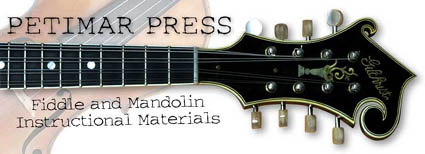« August 2010 |
Main
| October 2010 »
 September 23, 2010 | Pete Martin Jazz Chord Book
September 23, 2010 | Pete Martin Jazz Chord Book
Upper west coast multi-instrumentalist and teacher Pete Martin has prepared a dynamic resource for any mandolinist wanting an in depth study of jazz chord voicings in his method book aptly titled, "Jazz Chording for Mandolin." Included are a full 202 pages loaded with not only the chord diagrams, but a historical evolution of their context in the last century, from the swing tunes of the 20's & 30's, Bebop developments of the 40's and 50's, and the modern "rootless" voicings crucial to playing jazz and pop from the late 50's and beyond.

You could cut to the chase and read the appendices at the end of the book for immediate voicings, scales, and theory basics, but the best way to embrace his material is to start from the beginning and work all the way through his real world examples of well known literature. His text is easy to understand and extremely practical.
A "historical" approach is an excellent way of understanding chord vocabulary. Jazzers didn't just jump into b9 chords or polytonality in the beginning of the 20th century. Not only does it help to see how they arrived at the modern voicings, it helps to play some of the oldest jazz tunes in their proper context, devoid of the contemporary alterations. Know where you've come from to know where you are going.
Also, breaking up the chords into 4- and 3-note categories is excellent for the 5- and 10-string musician, or anyone wanting to be able to utilize the entire fretboard for efficient chord movement. Of course, visualizing them in the context of an actual song is pure gold.
The material is not available in the traditional publishing channels, only online through his website, and through an "honors system" download. You load it on your computer, look it over, and pay the author if you like it and will use it. We pretty much guarantee you WILL use it. Just the chords themselves are worth the $10, and the history exponentially more. In the days of prolific e-reader opportunity, this format makes even more sense than when it was first published in 2008. We have it loaded on our iBook reader on an iPad; great to study on a plane or waiting in the doctor's office.
Put this in your e-library or print it out at Fed-ex Kinkos, and send the man your money!
Website: Petimar Press
Download:  Jazz Chording for Mandolin Jazz Chording for Mandolin
Further:
When is a #9 NOT a #9?
Mobility--chord transit
The Seven Chord Naming Rules
I got rhythm. Who could ask for anything more?
Posted by Ted at 9:51 AM
 September 16, 2010 | Pick propulsion
September 16, 2010 | Pick propulsion
Last week we looked at the "strike," the articulation point of attack where pick meets string. It's an important concept to understand, but it's only a part of the picture. The next issue in good mandolin tone is timing, coordinating the left and right hand to get the maximum amount of sustain through a succession of repeated notes.

The metaphor of a playground merry-go-round is our picture in a fourth dimensional look at picking. We've used it before where you imagine pushing a child round and round, keeping the speed constant. Once you get it going, any variation in your push can cause the speed to falter. Hold your grip too long, you slow it down. Don't push in sync, and you interfere with the smoothness of the turn.
The "stop and start" impact is not unlike bad pick technique. Unfortunately, the professional Bluegrass realm is full of examples of this kind of "motorboat" effect, the propeller-like sound of pick and string at high tempos, and that "thup-pa thup-pa thup-pa thup-pa" sound is arguably unpleasant even at pyrotechnical speed. The start of a pick should never drastically impact the end of the next note, and in show-off soloing, you hear this once in awhile. Good picking is about starting the sound, not stopping it.
Effective pick control starts at slow tempos, and progresses in players only when developing the ability to intentionally drive the tone one note through to the next. We introduced an exercise to help you hear this in our Lydian DUDU drill from the Getting Into Jazz Mandolin book. The goal is to be able to play it when moving fret to fret, as well as crossing strings. The single note repetition at the end of the 2nd measure gives you the opportunity to setle into a well-timed swing of the pick.
Give it a try:  Lydian DUDU Lydian DUDU

Further:
Another look at Flying Fingers
Components of Tone
Mind the Gap
Fear of Flying
Posted by Ted at 5:32 AM
 September 9, 2010 | The perfect swing
September 9, 2010 | The perfect swing
Must be something about the season, the pending race for the pennant, and ultimately the World Series next month that gets us thinking, and hearing swamp ash against thread and leather. We've used this metaphor many times before in describing what happens with the perfect pick strike, that moment in time when a perfect swing meets material, ball against bat, plectrum against string. It bears repeating.

Bow sustains violin string, breath sustains trumpet phrase, and electronically, a guitar sound can be pushed indefinitely, but we plectrum artists only get one shot to make a clear bell-like sound. Sure, you can argue for tremolo, but you still need a healthy pick stroke to hit that tone out of the park. Many try to make up for a lack of sustain by playing faster. You might as well wobble your index finger over blowing loose lips. You aren't going anywhere unless you start a sound premeditatedly with intent and definition.
The only way to master this is to slow everything down. If you can't do it at turtle tempo, you certainly can't at hare. We introduced an exercise not long ago "Wholesome Notes" that took four simple notes to get a crystal clear sound

If you've been playing awhile, don't be afraid to go back and check your attacks and articulations out. Maybe you've been mastering scales and arpeggios, or grinding out a healthy fret finger sustain. Super if you are, but we can't stress enough, none of this means anything if you aren't starting your sound with good tone.
If you don't think you're objective enough, record your sound. Imagine doing a jingle, and you're recording your four whole notes for a Superbowl commercial. Is your audience going to be impressed? Are your notes as full and resonant as they possibly could be? Have you unhinged every vibrating cell in your mandolin you could possibly stimulate? Thrown the sound of the string to the grandstands?
Next, review our exercise "Sweeping for Tone." Note this is also a good step into developing control for tremolo. Finding that magic, illusive intersection between confident pick grip and loose, relaxed hands starts here, too. There simply are no shortcuts.
Print PDF: Sweeping for Tone
Further:
The Crack of the Bat
Starting with good tone
The virtues of sustain
Using the picking hand to start Good Tone.
Posted by Ted at 5:37 AM
 September 2, 2010 | Altered States
September 2, 2010 | Altered States
Recently we received a question about Altered Scales we thought appropriate to share. Peter writes, "I have practiced the diminished whole tone, half tone scale which you introduced in Jazz Mandology. I am somewhat curious as to whether this scale is only used to resolve to minor keys (such as in Minor in Possession) or does it resolve equally to major keys as well?"
The answer is yes, it can be used in Major Scales. Simply a matter of personal taste, we like its harmonic flavoring in the minor mode, but nothing says you can't use it elsewhere. When you spell out the individual elements of a V7 chord, especially one with a b9 added, you have some commonality:
Key of B minor, V7(b9) = F#, A#, C#, E, G
F# Altered scale = F#, G, A, Bb, C, D, E, F#
Note the harmonic and enharmonic similarities; really, the only superfluous notes are A and C (Bb and A# are the same note). A is the 7th, and can either be raised or lowered as part of the B minor scale. C is a color tone we added when we arbitrarily flatted the 9th of the V7 chord.
We believe the Altered Scale is the second most important scale you can learn. The first? Why a major scale of course, because with its WWHWWH step sequence, you have all the modes (Dorian, Mixolydian, Lydian, etc) covered. Learn a major scale cold, and all you have to do is start it on a different scale degree to get these other precious modes.
In an Altered Scale, you have three in one. With the F# Altered Scale, you also have a tasty treat, our favorite Aug 11th Scale (start on the C):

Notice if you start the same sequence of notes on the G, you have a third delicious scale, a G Melodic Minor Scale, G, A, Bb, C, D, E, F# G.
How can you beat that? The trick is to get this into your fingers, the fret relationships, where you skip frets and/or cross strings, and over time, they become subliminally fertile. Granted, initially the Altered Scale can be quite foreign to the unaccustomed ear. This is one you'll just have to trust on, for now. Spend a few months on it. Get a tactile intimacy with it.
Someday your ear will get friendly with it, too!
Further:
Bebop Mandology
Some Minor issues: Seeking Resolutions
Sometimes things are less than they seem.
Fingers, Ears, Brain.
Easing into Modal Jazz
Posted by Ted at 5:50 AM

Disclaimer: In the 'Information Age' of the 21st Century,
any fool with a computer, a modem, and an idea can
become a self-professed 'expert." This site does not
come equipped with 'discernment.'
|



